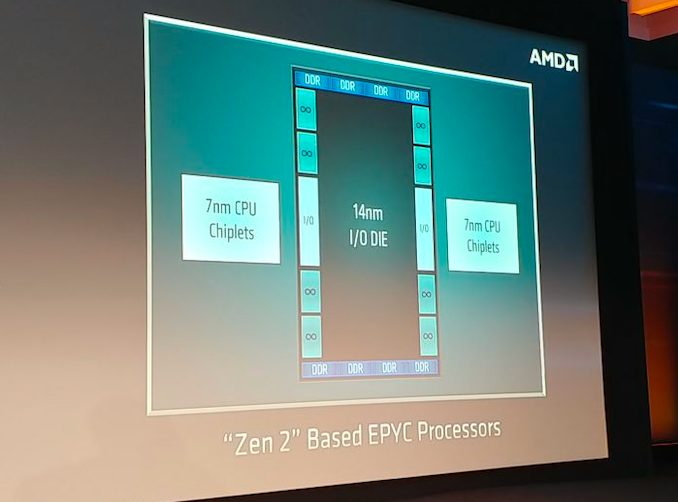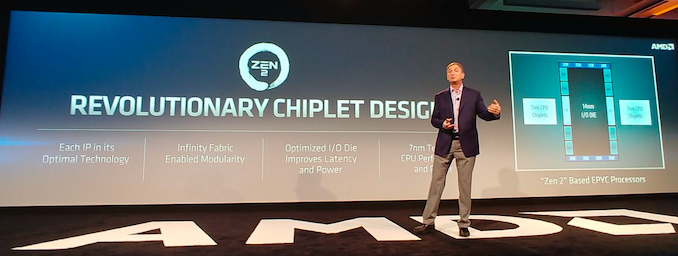AMD Unveils ‘Chiplet’ Design Approach: 7nm Zen 2 Cores Meet 14 nm I/O Die
by Anton Shilov on November 6, 2018 1:53 PM EST
AMD on Tuesday disclosed some additional details about its upcoming codenamed Rome processor based on its Zen 2 microarchitecture. As it turns out, the company will use a new design approach with its next-generation EPYC CPUs that will involve CPU ‘chiplets’ made using TSMC’s 7 nm manufacturing technology as well as an I/O die made using a 14 nm fabrication process.
AMD’s chiplet design approach is an evolution of the company’s modular design it introduced with the original EPYC processors featuring its Zen microarchitecture. While the currently available processors use up to four Zen CPU modules, the upcoming EPYC chips will include multiple Zen 2 CPU modules (which AMD now calls ‘chiplets’) as well as an I/O die made using a mature 14 nm process technology. The I/O die will feature Infinity Fabrics to connect chiplets as well as eight DDR DRAM interfaces. Since the memory controller will now be located inside the I/O die, all CPU chiplets will have a more equal memory access latency than today’s CPU modules. Meanwhile, AMD does not list PCIe inside the I/O die, so each CPU chiplet will have its own PCIe lanes.
Separating CPU chiplets from the I/O die has its advantages because it enables AMD to make the CPU chiplets smaller as physical interfaces (such as DRAM and Infinity Fabric) do not scale that well with shrinks of process technology. Therefore, instead of making CPU chiplets bigger and more expensive to manufacture, AMD decided to incorporate DRAM and some other I/O into a separate chip. Besides lower costs, the added benefit that AMD is going to enjoy with its 7 nm chiplets is ability to easier bin new chips for needed clocks and power, which is something that is hard to estimate in case of servers.
This is a breaking news. We are updating the news story with more details.
Source: AMD











76 Comments
View All Comments
nandnandnand - Tuesday, November 6, 2018 - link
I think we could. Ryzen 4-8 core parts could become very cheap. The cheapest 8-core launch price was $300 for Ryzen 2700. Maybe we could see that dip down to $150-200, with 12 and 16-core options at the high end.Also hoping for 8-core laptop APUs.
0ldman79 - Tuesday, November 6, 2018 - link
Agreed.I really want an 8 core laptop, even if it throttles when all 8 are in play.
I could take 4GHz single or dual and 2GHz with all 8. A lot of apps need threads, a lot need single core. It's certainly possible.
Hell, my 45W i5 6300HQ typically only pulls 27W at full load, takes Prime95 or something similar to actually bump the 45W TDP and that's on 14nm. Surely they can get an 8 core under the same power limits on 7nm.
FreckledTrout - Tuesday, November 6, 2018 - link
Good point on cutting costs but I was thinking it would help with performance by eliminating any cross chiplet communications like we see with cross CCX communications in Zen 1.TheJian - Wednesday, November 7, 2018 - link
I really hope they decide to KEEP the profits, not give them away to users. At this point AMD stock needs MARGINS and PROFIT, not this crap where they keep having basically break even quarters or losses. I mean multiple generations of great cpu/gpu and they keep screwing up pricing and trying to win pricing wars that are IMPOSSIBLE to win vs. NV/Intel. Do NOT keep pricing below the competition if you are competitive at their price range. There is no reason to keep discounting yourself to death.I'm shocked most people don't realize AMD has lost about $8B over the life of the company. They literally have NOT made a dime over the life of AMD. Do people understand this? When is it OK for AMD to charge enough to make real profits for REAL competition to last more than a gen or two? I want MORE R&D, yet people keep asking for cheap chips. Well don't be surprised when NV/Intel kick the crap out of them again and price sky high.
I'd gladly pay a little more to AMD today, for better chips tomorrow and so on. Otherwise, we'll see AMD out of the race again in 3yrs when Intel gets their crap together, and probably sooner with NV as they haven't even topped them yet. We don't need discounts, get a better job! If people can't afford a $500 chip or gpu every few years, they are running their lives WRONG. Time to cut cable, cell phone or something so you can afford your toys, or like I said get a better job.
Most people could just join TING and save a ton of cash yearly over ATT etc. My mother has been paying $13-15 for years vs. $76 from ATT for the same thing...LOL. A simple change of cell providers and she's got a free PC upgrade yearly (which of course I have to build as the tech guy in the family...LOL). $720 saved yearly just on a dumb phone. Me, I just cancelled it completely, free PC yearly now...LOL. Cut the cable cord too for faster internet and CRTV instead ($20 off CRTV18 coupon for year sub right now, not sure how long it lasts). It's easy to re-arrange your bills if you really want something, or in my case are just tired of paying people for crap I don't use anyway.
Agenda TV and cell phone rape bills are over for me ;) Now the family only pays for what we actually want/use. ATT can kiss our butts, cable tv too! All the free crap on roku, youtube etc and hallmark (~$30/yr)/crtv($80 xmas year subs for the family) and we have all we could watch and more. So much news/content on CRTV we don't even miss fake news or even FOX news now, which is being flushed down the toilet by the sons of rupert murdoch who are NOT fox people and want to turn fox into CNN. I hope CRTV sinks fox at this point and gets hannity etc one day :)
Save your money people. So many places to cut your bills easily (or simply get a better job). I digress.
PeachNCream - Wednesday, November 7, 2018 - link
You make a few good points, but need to work on your presentation in order to get you main message across. As-is, you're just coming off as a bit crazy.Targon - Wednesday, November 7, 2018 - link
AMD needs money, so $330 for third generation would make more sense at the high end. We might see 16 core for $500 and if it can hit 5GHz, that would really hurt Intel.nandnandnand - Wednesday, November 7, 2018 - link
OK, i'll admit $150-200 is a low estimate for 8 cores. I'll up it to $250, with 16 core Ryzen at $500.Der Keyser - Tuesday, November 6, 2018 - link
Very interesting development. I cannot quite figure how intersocket communications will work from that IO Chiplet (Assuming all 8 IF are for CPU chiplets).But this should lower production cost noticably not to mention increase yield from wafers considerably. Also - now they can create different IO chips for Ryzen, Threadripper and EPYC to keep productioncost down but reuse the chiplets across all CPU’s
Now: A major question arises: I assume this will make the CPU seem monolithic from an OS perspective (no SUB numa as accesstimes to memory will likelily be the same for all Chiplets?
What kind of general latency penalty will they be looking at compared to the monolithic Intel design?
eastcoast_pete - Tuesday, November 6, 2018 - link
@Anton: thanks for the coverage, really look forward to the updates. As mentioned below, I am especially curious if AMD mentioned if and how they improved infinity fabric's problems: power consumption and memory access.Some of the news is quite good: the new 256 bit wide floating point capability should help playing catch-up with Intel's supremacy in AVX, although the AVX512 capabilities remain an Intel exclusive, at least for now.
The chiplet approach is exciting, although much of it lives and dies with the updated and improved (hopefully) infinity fabric: the reason is simple. A key reason why a 28 core Xeon will always be more expensive than a 32 core Threadripper is that Intel likely looses a lot of dies to fatal flaws during manufacturing. Now, Intel is actually really, really good at making its 14 nm FinFet chips, but once you're scaling to many, many billion transistors (28 cores!), the likelihood that the die has a fatal flaw somewhere just increases, and you end up thrashing a lot of expensive silicon. A chiplet approach reduces that waste enormously: if one chiplet or the I/O die is faulty, you only have to discard that one, not the entire chip. The Achilles heel of any multi-part chip is the fabric, so that's the big question for me: did AMD improve infinity fabric's power consumption, and fix the issues related to heterogeneous memory access?
eastcoast_pete - Tuesday, November 6, 2018 - link
correction: ..trashing a lot of silicon. Not thrashing, although they may do that also (: